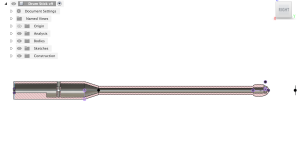The inspiration for this project came from many years of playing electronic music with a live drummer. When drummers play electronic music they try their best to keep perfect timing but as the humans they are, they might be a slightly early or a slightly late. In a recording studio this can be easily fixed by “quantizing” (i.e. syncing) the drum hits to the nearest 1/4th note, 1/8th note, 1/16th note etc. However that wouldn’t work in a live performance.

Technically, in an electronic live performance, if a drummer hits a drum pad too early it’s possible to delay the MIDI note until the next 1/4th note, 1/8th note etc. and only then release a MIDI note. But if the drummer hits the drum or pad too late it’s impossible to go back in time and release a MIDI note in the correct timing.

To solve this, this drum stick doesn’t detect the actual drum hit but rather the intention of the drummer. This drum stick is 3D printed and hollow, concealing a microcontroller and two IMUs (Inertial Measurement Unit) – one for orientation and one for acceleration – which allow it to predict the drum hit a few valuable milliseconds before the actual hit. This means that even if the drummer is late, their movement is registered early. As a by-product this drum stick doesn’t need to actually hit anything and can be played in the air.

If connected to a DAW (Digital Audio Workstation such as Logic, Ableton etc.) the drum stick can receive MIDI clock messages and “know” when the next 1/16th note should start. Combining these two factors, the drum stick can send a MIDI note at the exact time the drummer meant to hit the drum whether they are early or late. Choosing to snap the MIDI note to a 1/16th note allows the drummer a lot of flexibility and expression while still keeping them synced to the beat, a lot like Autotune, but correcting time instead of pitch.